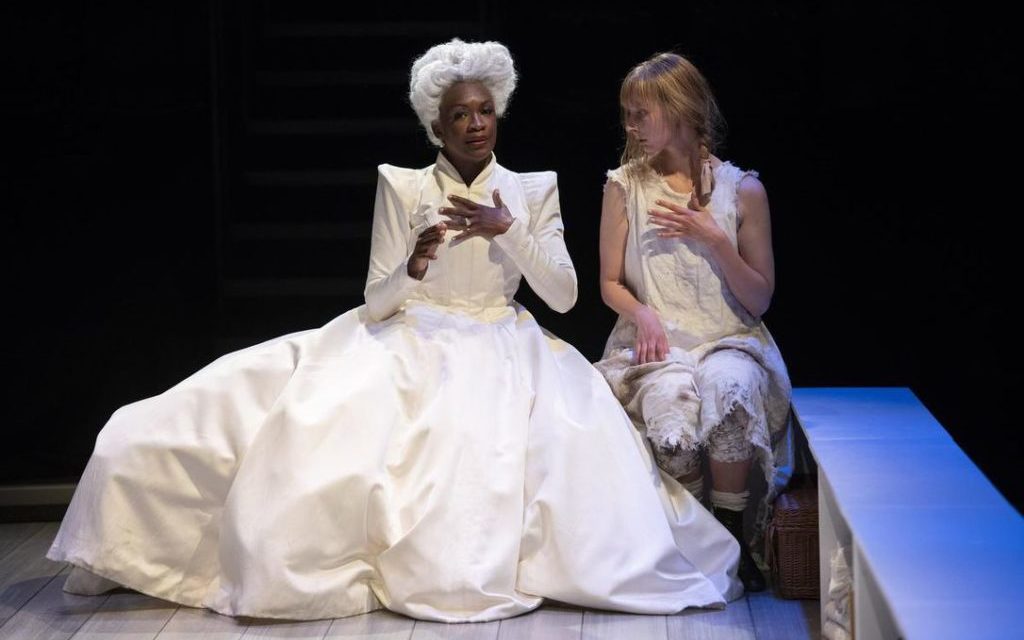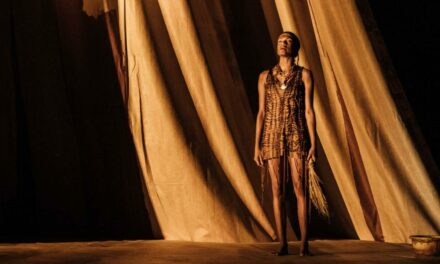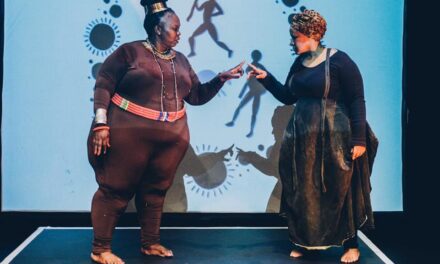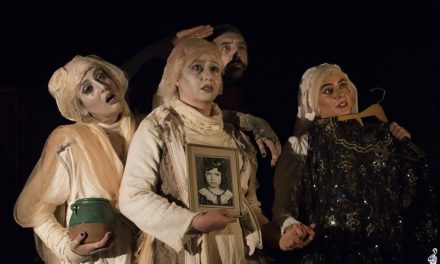The scene does offer some amusement. A benevolent Baroness has embarked on a key initiative in her Rousseau-inspired mission to prove she can create a useful maidservant out of a gibbering, feral girl who has essentially grown up among pigs.
The Baroness, portrayed with kindly but steely resolve by Yanna McIntosh, an actress whom we always want to watch, is trying to teach Emily the correct etiquette for answering the doorbell and greeting the new arrival with a silver tray on which a visitor’s card must be deposited.
Emily, played with slovenly, innocent charm by Julia Course, struggles to oblige but keeps getting things wrong during this make-believe exercise. The Baroness keeps gently admonishing her for vocally imitating the sound of a ringing bell, and for being more interested in the sight of her reflected image in the tray—a novelty to this uncouth child—than getting things right.
Watching the scene unfold, you find yourself thinking of that scene from My Fair Lady where an increasingly frustrated Henry Higgins attempts to convey to Eliza Doolittle the correct pronunciation of “the rain in Spain stays mainly on the plain” and that makes you think of the musical’s origin, Bernard Shaw’s Pygmalion. Which in turn makes you think of the original Pygmalion myth.
But you also find yourself deciding that the scene is not as much fun as these predecessors because of the lack of a convincing dramatic springboard for it to be happening at all. This leads to the suspicion that in writing this play— The Baroness And The Pig—Canadian dramatist Michael Mackenzie was certain he had a nifty situation but was less certain about how to bring it off.
The Shaw Festival’s printed program notes invite us to see the Baroness as a product of the Enlightenment, a believer in the power of reason as a conduit to a better life for all. So in fulfilling her grand design for transforming a “pure unsullied creature” into something presentable, she finds her guinea pig in this humble farm girl who really has been living with the livestock.
How far do we have to stay with this play before we become conscious of its preposterousness? At a recent matinee, some theatregoers saw intermission as a welcome opportunity to leave.
The program notes tutor us on what to expect. A dramatic discourse on the difference between instinctive behavior and the use of reason. An examination of the social gulf between the highest and lowest. Bewildering parallels with the Iraq war and Wikileaks—and be warned, director Selma Dimitrijevic doesn’t seem to be kidding when her printed comments toss these events into the pot!
And what else? Stark references to past horrors, involving sexual assault, also make a melodramatic and clumsy intrusion into the accumulated bafflegab.
Even a monstrous transfusion of Gorilla Glue would have trouble making this mess stick together. Yet hints of something more interesting occasionally struggle to the surface. As McIntosh’s Baroness tries to bring Julia Course’s grunting, snuffling Emily to some level of civilized behavior, there are also portents of approaching anguish—the anguish and pain of “knowing.” There are also intimations of something odd happening between the personalities of these two women, and fans of Ingmar Bergman’s Persona may well be intrigued.
Yet, the psychology of the play seems naive—no more so when the Baroness introduces her willing but floundering charge to Shakespeare’s Julius Caesar, and—hey, presto—Emily abruptly becomes savvy enough to respond by attempting something lethal with a knife.
Designer Camellia Koo is in an unworldly mood here with a minimalist set consisting of a pattern of rectangular benches, beneath which rest many books and assorted props. White is the overriding component of the costuming — McIntosh’s Baroness boasting a gleaming white wig and sweeping ballroom dress, and Julia Course, bedraggled in an off-white sack soiled by life in the pig sty and later scarlet with blood during a supposedly climactic moment in the script.
There’s a studied artificiality here, one that moves everything to the realm of fantasy, the sort of place where an eerie pas de deux between the two women seeks special significance. Director Selma Dimitrijevic has a feel for the visual, and she has worthy colleagues in Camellia Koo and lighting designer Kevin Lamotte. But neither their contributions nor the committed performances of McIntosh and Course conceal the reality of what’s happening. The Baroness And The Pig remains pretentious nonsense.
(The Baroness And The Pig continues to October 6. Further information at shawfest.com or 1-800-511-7429)
This article originally appeared in Capital Critics’ Circle on June 26, 2018, and has been reposted with permission.
This post was written by the author in their personal capacity.The opinions expressed in this article are the author’s own and do not reflect the view of The Theatre Times, their staff or collaborators.
This post was written by Jamie Portman.
The views expressed here belong to the author and do not necessarily reflect our views and opinions.


















